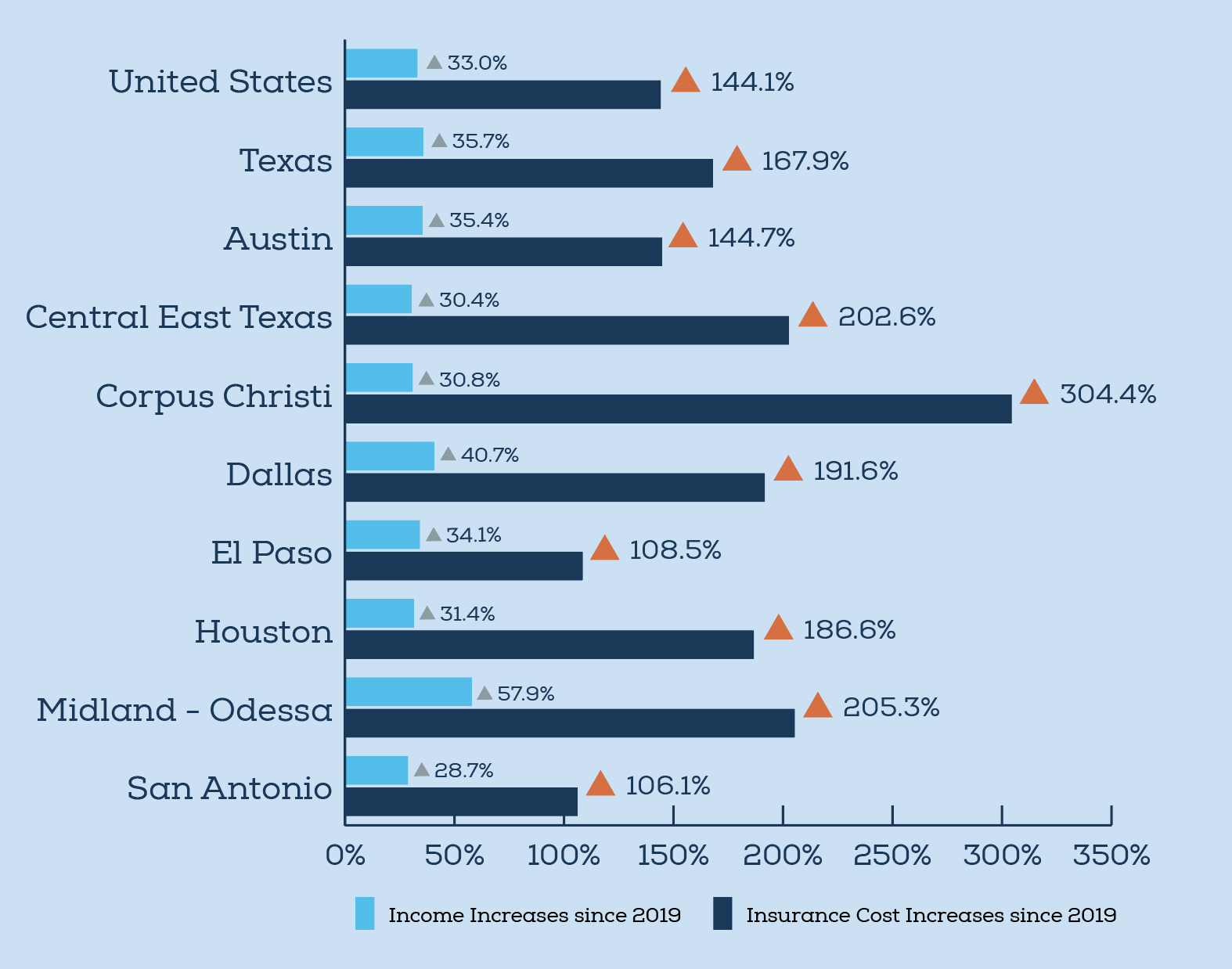
8 minute read
Affordable Housing Dealbreaker: The Imminent Threat of Rising Insurance Costs
By Elaine Acker for the Texas Affiliation of Affordable Housing Providers
Today, outside of taxes, insurance is probably the number one pain point for affordable housing owners and developers. — Thomas Dunbar, Ross & Yerger Insurance
In Texas and across the nation, affordable housing developers and operators are facing a growing crisis, and it’s not just construction costs or workforce shortages. It’s insurance.
The cost of property and casualty insurance for affordable housing communities has climbed dramatically over the past five years, (over 300 percent in some cases, according to Yardi Matrix, a leading multifamily data provider) adding another layer of complexity to an already challenging mission. According to Thomas Dunbar, a shareholder at Ross & Yerger Insurance, it’s become one of the top threats to project viability:
Ten or fifteen years ago, insurance was just another line item. Nobody lost sleep over it. Today, outside of taxes, insurance is probably the number one pain point for affordable housing owners and developers.
Every Texan can relate, because we’re feeling it in expenses like home and auto coverage. These are things that once were a simple checkbox in the budget. Now, the costs are under the magnifying glass and causing plenty of sleepless nights.
When insurance costs spiral out of control, it threatens not just developments, but the sustainability of affordable housing programs statewide.
The Perfect Storm: Why Costs Are Soaring
Why is insurance hitting so hard now? It's a perfect storm of challenges:
Natural Disasters
Thom Amdur, Executive Director of Fairview Housing Partners and author of the paper: State and Local Policy Strategies to Address the Affordable Housing Insurance Crisis.
Texas is ground zero for many of these large disaster events. We’ve got floods, hail, tornadoes, and each one contributes to huge claims and pressures the entire insurance market.
Skyrocketing Construction Costs
Building materials like lumber have become more expensive, driven by tariffs, supply chain disruptions, and labor shortages. “If it costs 50 percent more to rebuild a building than it did five years ago,” says Dunbar, “insurers are going to charge 50 percent more in premiums just to stay in line.”
Increased Litigation
Insurance carriers are also battling a rise in lawsuits, and that’s often amplified by third-party litigation funding, where outside investors fund plaintiff lawsuits in exchange for a share of settlements. These lawsuits drive up defense costs, raise settlement payouts, and push insurers to increase rates for everyone.

Data Shows Insurance Costs for Texas Affordable Housing Providers Have Risen an Average 167.9% Since 2019
Source: Yardi Matrix, a leading multifamily data provider added an affordable housing component in 2024. Matrix tracks 26,000 fully affordable properties with 3.5 million units nationally.

Fewer Carriers, Less Competition
Today, even though there are thousands of property insurers nationwide, very few are willing to underwrite affordable housing projects, especially older or wood-framed properties.
Most wood-framed affordable housing developments are seen as higher risk,” says Dunbar. And most affordable housing developments are wood framed. “Insurance carriers are being extremely selective, and they don’t have to fight for business right now.
Adding to the strain, some insurers are now declining to cover properties over 20 years old, regardless of their condition, making it even harder to secure insurance for long-standing affordable communities.
Rents in affordable properties are tied to local median incomes and program regulations. Developers are locked into rent caps designed to protect working families, and that’s a good thing. But it also means they have no real way to absorb these surging costs.
Market-rate developers can offset an insurance increase by raising rents. Affordable housing owners can’t,” Dunbar explains. “They’re stuck absorbing the cost or cutting elsewhere.
Worse still, insurance companies sometimes charge higher premiums simply because a property serves low-income tenants — a practice rooted in outdated assumptions about crime risk, despite today’s strong management standards and rigorous compliance standards for affordable communities.
The result? Maintenance budgets get slashed. Staff cuts follow. Services to residents — things like after-school programs, financial literacy classes, and mental health support — may have to be negotiated and reduced or eliminated.
And if insurance rates continue to spike, Amdur warns it could put properties into financial default, leading to foreclosure. “And when that happens,” he says, “affordability protections disappear. Entire communities lose critical affordable units.”
Once a property goes into foreclosure, affordability requirements tied to tax credits are stripped away. The property can be sold on the open market with no obligations to stay affordable, accelerating the loss of critical housing stock.
Imagine a small nonprofit that owns a 60-unit apartment complex for low-income seniors. When insurance costs rise by 50 percent, that nonprofit faces an impossible choice: skip roof repairs, raise resident fees (if allowed), or dip dangerously into reserves.
Multiply that scenario by hundreds of properties, and the stakes become painfully clear.
What Happens If We Don’t Act?
If this trend continues unchecked, here’s what affordable housing providers say we can expect:
New developments stall: Rising insurance premiums add millions in additional costs to new projects, making financing gaps harder to close.
Existing properties deteriorate: While most developments anticipate regular insurance increases, today’s cost increases are much higher — with no certainty increases will level out. Consequently, maintenance and vital repairs are often deferred, leading properties to fall into disrepair. This decline damages the perception of quality among developments in the tax credit program, making investors less willing to support future essential affordable housing supply.
Affordability protections vanish: Foreclosures and exits from affordability programs could eliminate thousands of units.
Communities feel the strain: Longer commutes for teachers, bus drivers, EMTs. Increased traffic, slower emergency response times, and lower quality of life.
If you've got security cameras, locking doors, and good lighting, you shouldn't be at risk for a huge negligence suit. — Thomas Dunbar, Ross & Yeger Insurance
Affordable housing providers are further constrained by federal rules allowing only one rent adjustment per year, leaving them vulnerable when costs like insurance skyrocket midyear. Insurance isn’t just an expense line anymore. It’s a force that could reshape our communities if we aren’t proactive.
Strategies and Solutions
There’s no single solution, but affordable housing leaders and policy experts are rallying around several strategies:
Premises Liability Reform: One way to lower insurance costs is to reduce frivolous lawsuits. In 2023, Florida passed legislation limiting property owner liability if basic safety measures like security cameras, deadbolts, and lighting are in place.
Adopting similar reforms in Texas could help stabilize general liability premiums and make affordable housing more insurable.
If you’ve got security cameras, locking doors, and good lighting, you shouldn’t be at risk for a huge negligence suit,” says Dunbar.
Expand FAIR Plans FAIR (Fair Access to Insurance Requirements) plans are government-backed insurance programs for high-risk properties. Expanding these programs and raising their coverage limits to reflect today's construction costs could provide a much-needed backstop for affordable housing.
Colorado recently expanded their FAIR plan to allow up to $5 million in coverage for commercial properties, offering a model Texas could explore.
Promote Competition in the Insurance Market Opening the door to more insurers willing to cover affordable housing is critical. The basic laws of supply and demand apply here.
We need more competition,” says Dunbar. “The fewer companies willing to write policies, the higher the costs.
Offering incentives, lowering regulatory hurdles, and sharing risk through community-based catastrophe insurance programs could bring more carriers into the fold.
Invest in Resiliency Building stronger properties with better roofing, flood protection, and fire-resistant materials can reduce future claims. Government grants or tax credits could help developers afford these upgrades during construction or major renovations. "Investing in resilience today reduces the risk and the cost of claims tomorrow,” says Amdur. “It’s a win-win."
Push for Better Data There’s a massive gap in data around claims and losses specific to affordable housing. Without better data, policymakers are flying blind. States like New Jersey are starting to collect this information. Texas could do the same, giving leaders the facts they need to drive smart reforms.
Protecting Our Communities
At its core, affordable housing isn’t about units. It’s about Texans living in thriving communities. If rising insurance costs squeeze affordable housing out of the market, the impacts will ripple far beyond property developers. It will affect schools struggling to hire teachers. Hospitals scrambling for nurses. Cities battling traffic congestion and labor shortages.
In Texas, where we pride ourselves on resilience, independence, and opportunity, we can’t afford to sit back and wait for things to change. “Protecting affordable housing is protecting the future of our communities,” says Amdur. “We have to be proactive. Not reactive.”
Being Proactive
If you're a policymaker, business leader, or concerned citizen, now is the time to act:
• Support legislation that addresses premises liability, FAIR plan expansion, and insurance discrimination.
• Champion resilient building policies that reduce future risks.
• Partner with affordable housing developers to advocate for solutions that strengthen our communities.
The insurance crisis isn't merely a policy issue; it's a call to action. Now is the time to lead, take decisive action, and invest in Texas's future.
ARE YOU INTERESTED IN AFFORDABLE HOUSING POLICY ISSUES?
TAAHP offers various ways for members to stay informed and get involved. Members receive monthly e-mail newsletters with the latest industry news, policy updates, and events. TAAHP members interested in a more active role can join committees to help shape advocacy and industry initiatives. For more information, visit www.taahp.org

Call to Action
Protecting affordable housing is protecting the future of our communities. We have to be proactive, not reactive." — Tom Amdur, Senior vice President, Policy & Impact, Lincoln Avenue Communities










